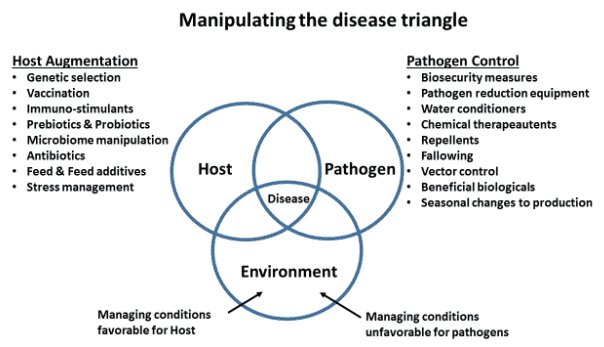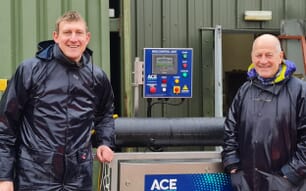Some consumer concerns are being addressed with various certification programs, but even with such certification, customer trust may be hard to earn in countries in which industry is notorious for using much more antibiotics than do other producers in different parts of the world.
Disease should never be considered “normal”
Most producers would agree that the use of antibiotics is something they would like to avoid, but for some, it’s viewed as a necessary evil to stay viable.
Although there are times when it is needed, its use never should become a common production practice. It should just be a tool for giving the operator a second chance at fixing problems in their production.
Some diseases in farming may be common, but they should never be considered “normal.”
Viewing disease as abnormal should result in a review of one’s husbandry practices, production inputs, and use of equipment and infrastructure.
Having inhouse talent, experienced service providers, or a combination of both involved in reviewing the implications of production method on fish health are important for mitigating the risk of disease and the need to use antibiotics.
The best companies in industry accomplish this with a holistic approach to fish health, which comes in part from an in-depth understanding of all aspects of the disease triangle and how it can be manipulated.
Postponing implementation: All companies manipulate and manage this triangle to some degree; it is just a matter of how well they do it, and to what level they are willing to do what is necessary.
Managing the cost of implementing various protocols is always a factor, and gambling that profit margins can be increased by making compromises to certain aspects of production is a part of farming.
The art comes in knowing where to invest and where to cut. Newer industries and new farms often have a “honeymoon” period wherein problems are minimal and the cutting of corners is rewarded with higher initial profit margin.
Eventually the honeymoon ends, disease strikes and strikes hard, due to lack of controls and good practices. Re-tooling infrastructure and making changes to established production models afterward can be expensive and painful.
In many instances, corrective changes are not taken and longterm viability is sacrificed for short-term gains. Unfortunately, the end result can be a decision to use antibiotics as a crutch rather than to fix problems.
The tendency is to be reactive rather than proactive, and such leads to the root causes of poor health being ignored. It is a practice of delaying the pain of correction and of creating much greater problems down the road. At some point, the idea of looking into the root causes of poor health becomes an afterthought, as resources are focused on putting out fires rather than preventing them.
Evaluating the true benefit: Although a number of practices, production models, and infrastructure investments are selectively cut out of the production matrix for financial reasons, many of them are not all that expensive when put in the context of long-term financial viability.
Such benefits are much easier to see when comprehensive data collection is part of the operation and associations can be made between past actions and results.
Collecting the right data and reviewing it with a ‘big picture” point of view is also highly important for making the right decisions.
The cost of implementing practices in the hatchery can’t just be compared to the benefits seen during the hatchery stage. Cost also needs to be compared to all the benefits seen through grow-out and even to the quality of product harvested. Such is much easier to implement for the integrated company than it is for the grow-out company that purchases from independent hatcheries, but it can still be done; it just requires more negotiation.
Company traits that promote low to no antibiotic use include:
- Executives have a long-term view of company viability and profitability
- Fish health management teams are also involved in production planning and husbandry
- Fish health management is focused on prevention
- Significant time is spent on identifying and mitigating the hidden stressors in production
- Production emphasizes animal welfare and maintaining a low-stress environment
- Data evaluation and technology are used to identify problems before they become problems
- Good records on all aspects of production are kept and reviewed for process improvement
- All aspects are evaluated, even the small ones, with respect to their impact on the “Big Picture”
- Communication is excellent within and between operational units.
- Formats exist for educating staff on how their actions impact overall performance
- Production infrastructure is cleaned or fallowed between production batches
- Compromised fish are more likely to be culled than to be used for production
- Operations are not vulnerable to single point failures in the production pipeline
- Backup options exists in the production chain to enable cleaning of compromised facilities
- Companies with limited backup options make heavier investments in prevention
Your Fish Health Management Team: Effective fish health management requires a set of knowledge that is rarely found in one single individual, and for this reason, a pairing of talents works best.
For large companies, recruiting their own team is possible. For small companies, the use of a service provider with such talent can be a great option. Examples of those who are great for such a pairing are veterinarians with a strong working knowledge of aquaculture systems and husbandry practices, as well as experienced fish farmers with a strong knowledge of the veterinary sciences.
When the talents are combined in a team effort to fully manage all angles of the disease triangle, the need for antibiotics can be greatly reduced.
Looking Forward: Aquaculture as a major agribusiness is relatively very young, and as it continues to grow in importance, its economic value and size will accelerate technological innovations for making it one of the most efficient and sustainable methods of protein production on the planet.
Such has already been seen in salmon farming, and it’s transformation into a technologically advanced industry has already paid dividends, especially as it relates to fish health. Such advancements now make it possible to be successful at farming salmon at a large scale in a manner that is sustainable and environmentally friendly. It also has provided the tools necessary for reducing the incidence of disease and the need to use antibiotics.
The great reductions in antibiotic use from past to present, as seen in Norway, is a perfect example of what technological advancements in the right hands can do, and it also paints a very good picture of where aquaculture as a whole is headed.




